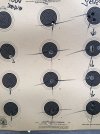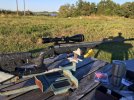As mentioned, loaded some of the 150 grain with RL23 and did some more in depth testing today in my 7Max, 24" proof barrel 1/8 twist.
View attachment 446267
Started out seated at 3.030 (0.020 off the lands) running a 0.282 mandrel for .002 neck tension, and used a Lee fcd for a light crimp. Fired 2 rounds at each of the powder charges below.
60.5 - 2988
61.0 - 3010
61.5 - 3040
62.0 - 3071
62.5 - 3101 slight ejector mark
63.0 - 3146 slight primer cratering, no ejector
Then proceeded to test different seating depths and powder charges, The groups came together better at a COAL of 3.010 (0.040 off) best group at 100 yards today was 61.0 grains seated 3.010 running 3030 fps
View attachment 446272
Would like to know what others have done with neck tension, I've got 21st Century mandrels and can dial it in to .0005 if it would help.
Also wondering whether to crimp or not, specific to the Badlands BD2. The crimping seems to help with the Hammer bullets, I don't have enough experience with the Badlands yet to say if it does or not.
I prefer to stick with temp stable powders. So far I have tested the following with the 150 badlands in 7 Max:
H1000 - 68.0 (compressed) 2989 fps, no signs of pressure
H4831sc - hit pressure between 66.0 and 67.0 running 3108 fps
In my earlier testing with RL23 (in warmer temps) I was able to get 65.0 grains in for a speed of 3144 fps, 66.0 grains (compressed) ran 3205 fps with a stiff bolt lift.
I've got some H4350, could try that but thinking it might be too fast.


